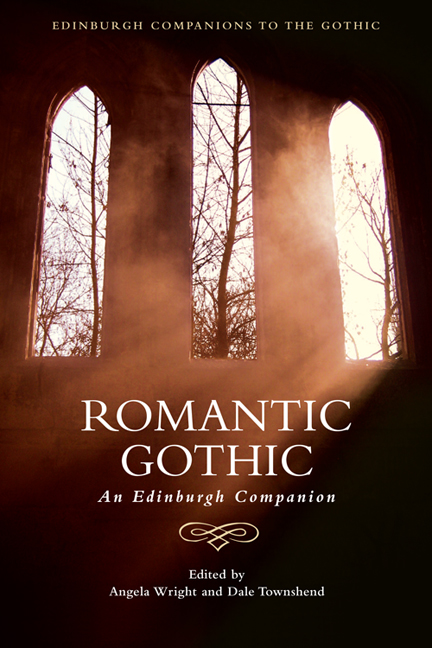Book contents
- Frontmatter
- Contents
- 1 Gothic and Romantic: An Historical Overview
- Part I Gothic Modes and Forms
- 2 Graveyard Writing and the Rise of the Gothic
- 3 Gothic Romance
- 4 The Gothic Stage: Visions of Instability, Performances of Anxiety
- 5 Gothic Poetry and First-Generation Romanticism
- 6 Gothic and Second-Generation Romanticism: Lord Byron, P. B. Shelley, John Polidori and Mary Shelley
- 7 Political Gothic Fiction
- 8 Shorter Gothic Fictions: Ballads and Chapbooks, Tales and Fragments
- 9 Oriental Gothic
- 10 Gothic Parody
- Part II National and International Borders
- Part III Reading the Romantic Gothic
- Notes on Contributors
- Index
9 - Oriental Gothic
from Part I - Gothic Modes and Forms
Published online by Cambridge University Press: 05 August 2016
- Frontmatter
- Contents
- 1 Gothic and Romantic: An Historical Overview
- Part I Gothic Modes and Forms
- 2 Graveyard Writing and the Rise of the Gothic
- 3 Gothic Romance
- 4 The Gothic Stage: Visions of Instability, Performances of Anxiety
- 5 Gothic Poetry and First-Generation Romanticism
- 6 Gothic and Second-Generation Romanticism: Lord Byron, P. B. Shelley, John Polidori and Mary Shelley
- 7 Political Gothic Fiction
- 8 Shorter Gothic Fictions: Ballads and Chapbooks, Tales and Fragments
- 9 Oriental Gothic
- 10 Gothic Parody
- Part II National and International Borders
- Part III Reading the Romantic Gothic
- Notes on Contributors
- Index
Summary
The Gothic is frequently identified with two obsessions: a concern with otherness and alterity, and a compulsion to explore socially aberrant desires and transgress boundaries. It is also a mode that disdains generic purity and embraces hybridity, hence the dismay it inspired in many eighteenth-century neoclassicist critics scornful of its mixing of genres, its stylistic excesses, its troubling popularity and its resolute illegitimacy. All these generic hallmarks of Gothic can be seen in its febrile intertwining with that other, older eighteenth-century and then Romantic mode, Orientalism. The Gothic and the Oriental manifest a shared concern with representing the alien and the other to European cultures, yet it is also a truism of Gothic and Orientalist criticism that both may be used as a means of representing the dark, irrational and monstrous at the heart of British society. The despotism and violence of Gothic and Orientalist narratives often reflect on the iniquities of eighteenth- and nineteenth-century patriarchal and bourgeois ideologies, especially the power of men over women. Both Gothic and Oriental were crucial modes by which British nationality and subjectivity were constructed (Sage 1988; Schmitt 1997). They were also notable modes in which authors used exoticism and excess to explore alternative or unstable sexual identities and desires. Despite the frequently heavy, often unconvincing surface moralism common to both genres, such narratives were able vicariously to employ exoticism to represent non-heteronormative desires and practices, safely distanced from the reality of an often savage eighteenth-century and nineteenth-century social and legal repression.
The Romantic period has sometimes been described as an ‘Oriental Renaissance’, as the growing European fascination with, and discovery of, Eastern languages, literatures and commodities such as tea, silks and porcelain fuelled the imaginations of writers and readers with Eastern or Oriental subjects. Both Gothic and Romanticism developed from Orientalism. In particular, the translation of the collection of popular Arabian and Persian tales – Alf layla wa layla, known in English as The Thousand and One Nights or The Arabian Nights by Antoine Galland – into French (1704) and by others into English (1712 onwards) firmly established the British cultural fascination with the East (Schwab 1984; Leask 1992; Sardar 1999; Macfie 2002; Ballaster 2005; Hoeveler and Cass 2006; Makdisi and Nussbaum 2008; Cavaliero 2010; Garcia 2011).
- Type
- Chapter
- Information
- Romantic GothicAn Edinburgh Companion, pp. 167 - 184Publisher: Edinburgh University PressPrint publication year: 2015



